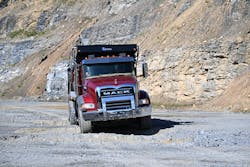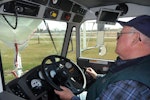Mack ‘Command Steer’ Adds Power to Power Steering
Driving’s much easier for hard-working drivers, thanks to Command Steer, an intelligent electric-boosted variant of Mack Trucks’ normal hydraulic power steering. Though it’s not a new product, Mack is placing new emphasis on the option, introduced several years ago on vocational and highway truck models. It reduces effort and eventual fatigue caused by traveling over rough terrain, in high crosswinds, and on crowned roadways, executives said during a demonstration in a rock quarry outside of Easton, in Pennsylvania’s Lehigh Valley near the builder’s ancestral home of Allentown.
Trade press reporters drove a pair of Mack Granite dump trucks and two Mack Anthem highway tractors, one of each type with Command Steer and one without, to experience the difference the device makes. The electric assist made the chore of piloting the dumpers over a severely scalloped surface in the quarry’s pit noticeably easier, but not so much with the bobtailing tractors on a gentler gravelly course. Product planners said the electric assist in the tractors would be far more valuable in prevailing winds, such as in many western states, and on crowned pavement that slopes to aid water drainage, which are found in many areas. Those conditions, of course, were not present in the quarry’s pit.
The Command Steer advantage in the Granite dumpers, though, was obvious and impressive. Driving the standard and electric-boosted dumpers through the extremely bumpy path revealed the considerable amount of muscle added by the device—up to 10.7 lb.-ft., according to Tim Wrinkle, Mack’s senior manager for vocational trucks, who rode along as the instructor. The closely spaced perpendicular ruts shook the cab and twisted the frame, and the standard steering sometimes wrested the wheel from my grasp. But with Command Steer, the steering wheel remained steady and all but unaffected by the mechanical violence beneath us. Sensors in the steering column and elsewhere were reading what was happening and instructing the electric motor on the gearbox to make constant corrections, Wrinkle said. These translated to the smoothness in the wheel at my hands. Actually, much of the time I took my hands off the rim and watched as the truck steadily continued straight ahead.
“Return to neutral” is among Command Steer’s features, and came into play during turning maneuvers with the dumper and the tractor. This helps drivers who are maneuvering around a job site. The driver doesn’t have to use the usual hand-over-hand method of turning the wheel quickly to change directions while backing a trailer or pulling it through tight spaces, said Stu Roselli, director for Mack’s on-highway segment. Just let go of the wheel and it quickly returns to the straight-ahead position, though not so fast as to batter one’s hands or wrists. That’s why the dump truck moved straight ahead without manual input from me.
Command Steer also quickened steering-gear action during a run through a slalom defined by orange traffic cones. It helped me make continuous tight turns in both directions with little effort, and allowed me to better keep my eyes on where the truck was in relation to the cones. Without electric assist, I had to work the wheel hard to make up for the hydraulic system’s comparatively sluggish response. I didn’t time my two runs, but I think the one in the Command-Steered Granite was quicker, and it certainly was easier on my arms and shoulders. Dump truck drivers don’t normally run slalom courses, but they make many other tight turns in a workday. I have to agree that the reduced effort really would cut fatigue, and might make drivers more productive, which is another claim Mack makes for Command Steer.
Volvo, Mack’s sister company, calls the electric-assist product Dynamic Steering, and offers it on its VHD vocational and VN highway models. It was developed over several years by Swedish engineers at Volvo Group, parent of both U.S. builders. The builders also share automated manual transmissions called I-Shift by Volvo and mDrive by Mack. All four trucks in this Mack demonstration had mDrive: standard 12-speeds in the Anthem tractors and optional 14-speed HD versions in the Granites; the extra two gears are low-low ratios in a short gearbox bolted to the main transmission’s main box (a 13-speed HD with one “crawler” gear is also available). All trannies shifted smartly and smoothly, greatly reducing driving effort and nicely complementing the added luxury of Command Steer.
The demonstration was hosted by Haines & Kibblehouse, a major contractor and owner of the sprawling Easton Quarry, plus 20 others in eastern Pennsylvania. H&K is also a big Mack customer, having bought its first two—U-model tractors to pull lowboy trailers—in 1969, according to John B. Haines IV, a company founder and current co-chairman. It’s fleet now includes scores of Mack trucks and tractors, from old R-models to late-model Granites. A son, James Haines, H&K’s president, and like other members of the owning family, he started out literally in the trenches, as a laborer. Four members from a third generation are now doing the same. John Haines has a huge collection of restored trucks and construction machinery in a place called the Haines Estate, in Montgomery County, illustrating his love for his life’s work.








